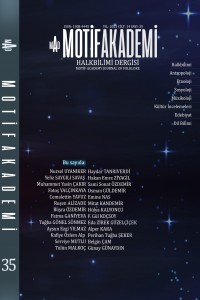ŞALGAM VE KANJİ: KÜLTÜRLERARASI BİR ÜRÜN OLARAK FERMENTE SİYAH HAVUÇ İÇECEKLERİ
ŞALGAM AND KANJİ: FERMENTED BLACK CARROT BEVERAGES AS CROSSCULTURAL PRODUCTS
Author(s): Sami Sonat Özdemir, Osman GüldemirSubject(s): Agriculture, Cultural Anthropology / Ethnology
Published by: Motif Halk Oyunları Eğitim ve Öğretim Vakfı
Keywords: Şalgam; kanji; black carrot; fermented beverage; cross-cultural;
Summary/Abstract: Fermented products have an important role in culinary cultures. Turkish cuisine culture is also rich in terms of fermented products. Among these products in Turkish cuisine, beverages can be exemplified by milk-based kumiss, ayran, kefir; cereal-based boza and pickled water consumed as beveragesfrom pickles obtained from many vegetables. Şalgam is essentially one of these fermented beverages in Turkish culture as an example of the pickle’s juices. However, kanji, which is one of the common cultural elements of Indian and Pakistani cuisine, is interesting because of its similarities with şalgam in terms of both production and consumption processes and structural features. Within the scope of this study, şalgam, which is considered as one of the Turkish cultural elements and creates social consumption habits, and the divergent and similar aspects of kanji adopted by Indian and Pakistani cultures are evaluated. The opinions of experts from the mentioned cultures were consulted with the help of draft questions prepared on the basis of “the method of determining the food origins”. As the products obtained by fermentation of black carrot, the possibility of similar products to take place in different cultures were also evaluated. Turkey, India and Pakistan’s neighboring countries, and participants from the region with the possible migration paths that they may spread are included to the interviews performed. As a result of the interviews, Turkey, India and Pakistan are decided to be evaluated in the axis. As a result of the analysis, it was seen that şalgam and kanji differed in terms of materials used in production, production time and being subject to industrial production. On the other hand, it has been revealed that the two products have similar aspects in terms of sensory properties, presentation and consumption, effect on health and so on. In future studies, it is important to carry out an in-depth analysis of the historical journeys of these beverages and the materials in order to make sense of the cultural connection of similar products produced by fermentation of black carrot. In addition, it is thought that studies including sensory, chemical and microbiological tests for the comparison of şalgam and kanji can contribute to various food-related disciplines.
Journal: Motif Akademi Halkbilimi Dergisi
- Issue Year: 14/2021
- Issue No: 35
- Page Range: 1074-1091
- Page Count: 18
- Language: Turkish

